

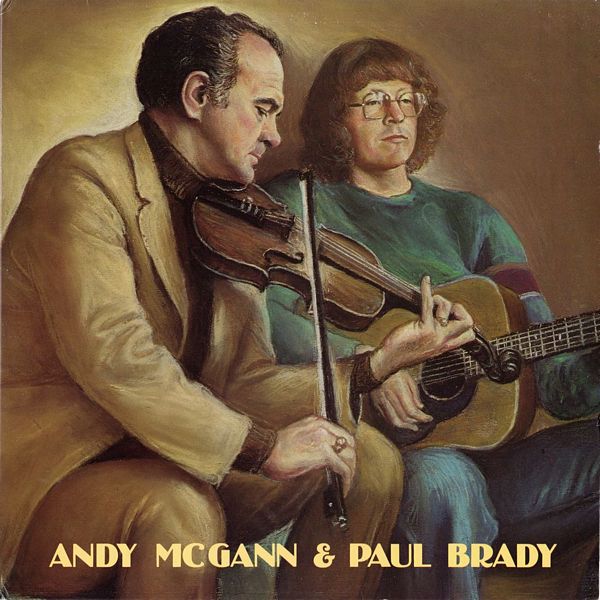 |
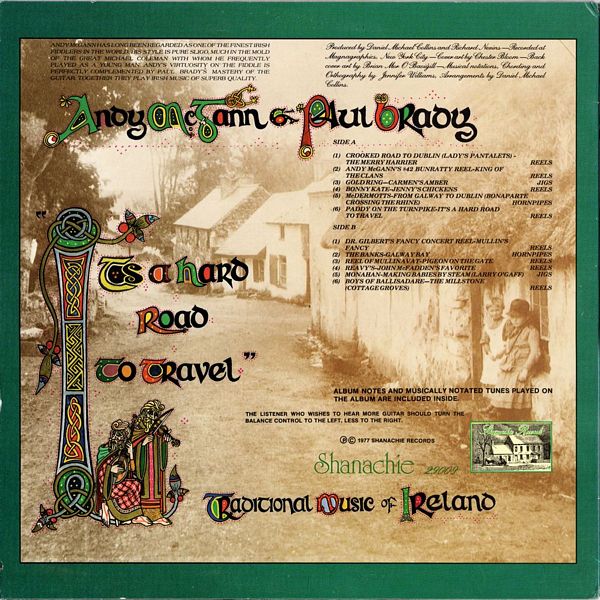
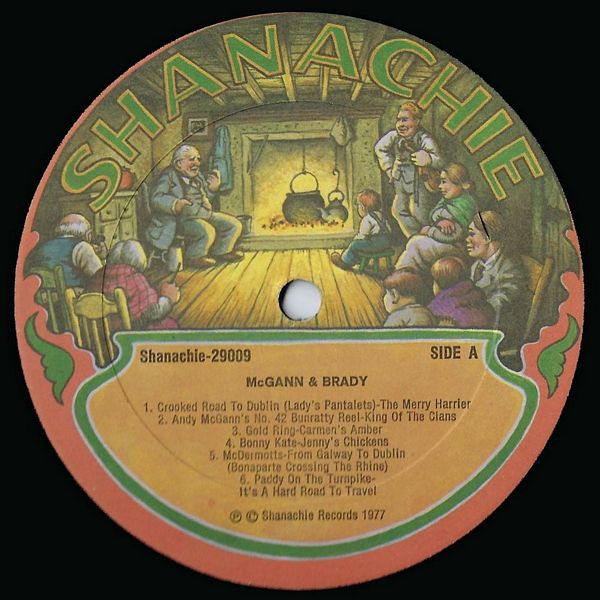
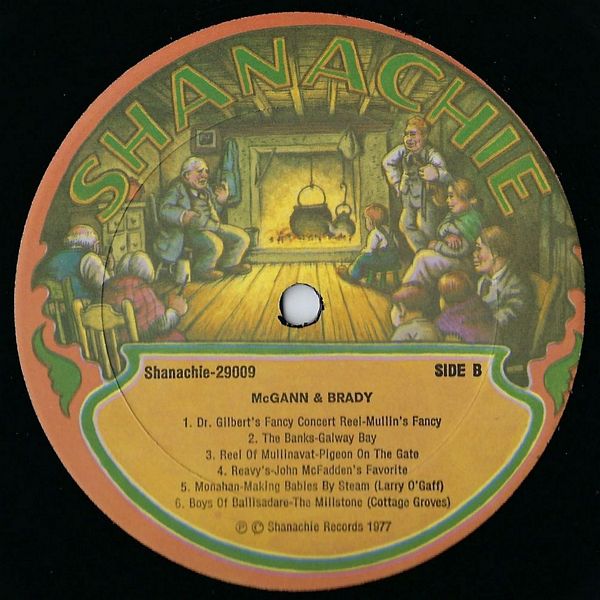 |
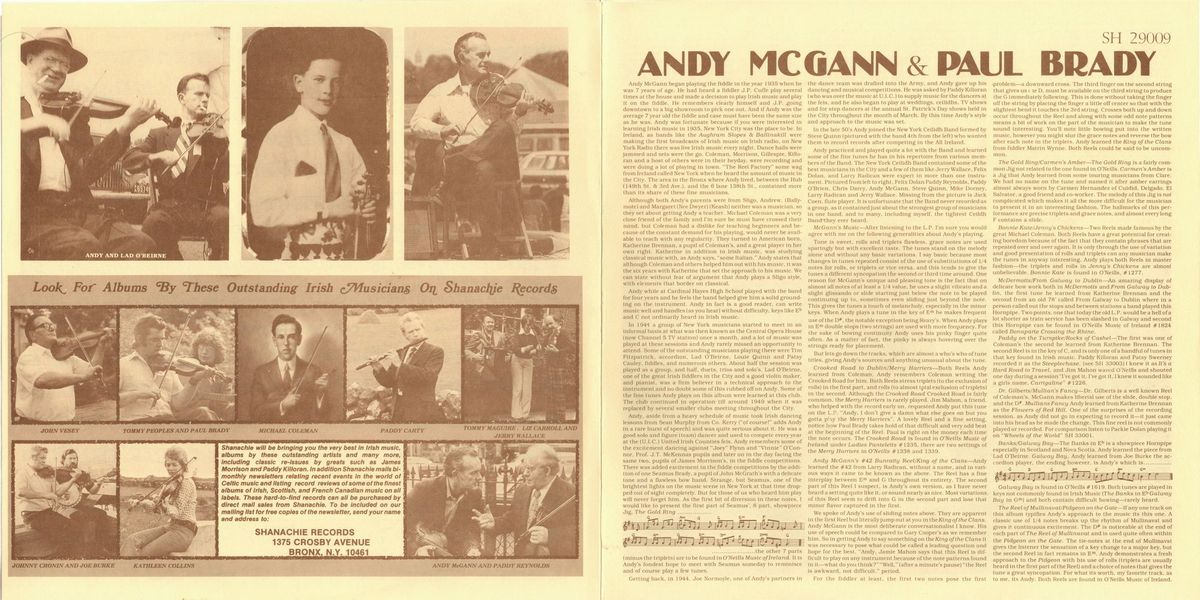
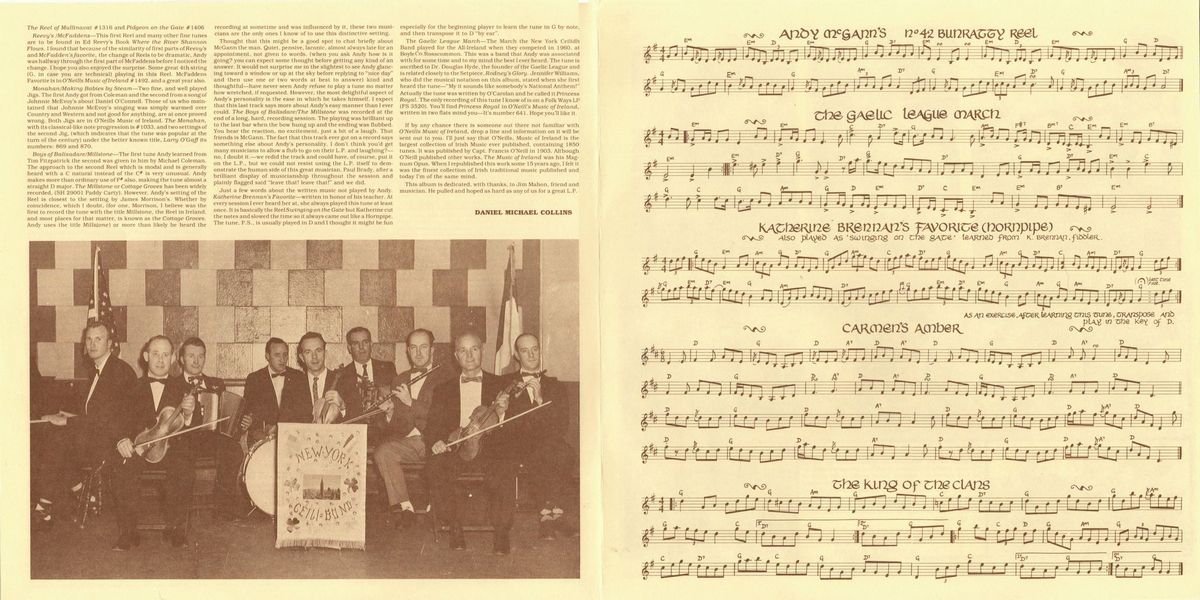 |
Sleeve Notes
Andy McGann has long been regarded as one of the finest Irish fiddlers in the world. His style is pure Sligo. Much in the mold of the great Michael Coleman with whom he frequently played as a young man. Andy's virtuosity on the fiddle perfectly complemented by Paul Brady's mastery of the guitar together they play Irish music of superb quality.
ANDY McGANN & PAUL BRADY
Andy McGann began playing the fiddle in the year 1935 when he was 7 years of age. He had heard a fiddler J.P. Cuffe play several times at the house and made a decision to play Irish music and play it on the fiddle. He remembers clearly himself and J.P. going downtown to a big showroom to pick one out. And if Andy was the average 7 year old the fiddle and case must have been the same size as he was. Andy was fortunate because if you were interested in learning Irish music in 1935, New York City was the place to be. In Ireland, as bands like the Aughram Slopes & Ballinakill were making the first broadcasts of Irish music on Irish radio, on New York Radio there was live Irish music every night. Dance halls were jammed and sets were the go. Coleman, Morrison, Gillespie, Killoran and a host of others were in their heyday, were recording and were doing a lot of playing in town. "The Reel Factory" some wag from Ireland called New York when he heard the amount of music in the City. The area in the Bronx where Andy lived, between the Hub (149th St. & 3rd Ave.), and the 6 lane 138th St., contained more than its share of these fine musicians.
Although both Andy's parents were from Sligo, Andrew, (Bally-mote) and Margaret (Nee Dwyer, Keash) neither was a musician, so they set about getting Andy a teacher. Michael Coleman was a very close friend of the family and I'm sure he must have crossed their mind, but Coleman had a dislike for teaching beginners and because of the constant demand for his playing, would never be available to teach with any regularity. They turned to American born, Katherine Brennan, a pupil of Coleman's, and a great player in her own right. Katherine in addition to Irish music, was studying classical music with, as Andy says, "some Italian." Andy states that although Coleman and others helped him out with his music, it was the six years with Katherine that set the approach to his music. We can state without fear of argument that Andy plays a Sligo style, with elements that border on classical.
Andy while at Cardinal Hayes High School played with the band for four years and he feels the band helped give him a solid grounding on the instrument. Andy in fact is a good reader, can write music well and handles (as you hear) without difficulty, keys like Eb and C not ordinarily heard in Irish music.
In 1941 a group of New York musicians started to meet in an informal basis at what was then known as the Central Opera House (now Channel 5 TV station) once a month, and a lot of music was played at these sessions and Andy rarely missed an opportunity to attend. Some of the outstanding musicians playing there were Tim Fitzpatrick, accordion, Lad O'Beirne, Louie Quinn and Patsy Cauley, fiddles, and numerous others. About half the session was played as a group, and half, duets, trios and solo's. Lad O'Beirne, one of the great Irish fiddlers in the City and a good violin maker, and pianist, was a firm believer in a technical approach to the instrument and no doubt some of this rubbed off on Andy. Some of the fine tunes Andy plays on this album were learned at this club. The club continued in operation till around 1949 when it was replaced by several smaller clubs meeting throughout the City.
Andy, aside from a heavy schedule of music took Irish dancing lessons from Seán Murphy from Co. Kerry ("of course!" adds Andy in a rare burst of speech) and was quite serious about it. He was a good solo and figure (team) dancer and used to compete every year at the (U.I.C.) United Irish Counties feis. Andy remembers some of the excitement dancing against "Joey" Flynn and "Vinnie" O'Connor, Prof. J.T. McKennas pupils and later on in the day facing the same two, pupils of James Morrison's, in the fiddle competitions. There was added excitement in the fiddle competitions by the addition of one Seamus Brady, a pupil of John McGrath's with a delicate tone and a flawless bow hand. Strange, but Seamus, one of the brightest lights on the music scene in New York at that time dropped out of sight completely. But for those of us who heard him play will never forget him. As the first bit of diversion in these notes, I would like to present the first part of Seamus', 8 part, showpiece the other 7 parts (minus the triplets) are to be found in O'Neills Music of Ireland. It is Andy's fondest hope to meet with Seamus someday to reminisce and of course play a few tunes.
Getting back, in 1944, Joe Normoyle, one of Andy's partners in the dance team was drafted into the Army, and Andy gave up his dancing and musical competitions. He was asked by Paddy Killoran (who was over the music at U.I.C.) to supply music for the dancers at the feis, and he also began to play at weddings, ceilidhs, TV shows and for step dancers at the annual St. Patrick's Day shows held in the City throughout the month of March. By this time Andy's style and approach to the music was set.
In the late 50's Andy joined the New York Ceilidh Band formed by Steve Quinn (pictured with the band 4th from the left) who wanted them to record records after competing in the All Ireland.
Andy practiced and played quite a lot with the Band and learned some of the fine tunes he has in his repertoire from various members of the Band. The New York Ceilidh Band contained some of the best musicians in the City and a few of them like Jerry Wallace, Felix Dolan, and Larry Radican were expert in more than one instrument. Pictured from left to right, Felix Dolan Paddy Reynolds, Paddy O'Brien, Chris Darcy, Andy McGann, Steve Quinn, Mike Dorney, Larry Radican and Jerry Wallace. Missing from the picture is Jack Coen, flute player. It is unfortunate that the Band never recorded as a group, as it contained just about the strongest group of musicians in one band, and to many, including myself, the tightest Ceildh Band they ever heard.
McGann's Music — After listening to the L.P. I'm sure you would agree with me on the following generalities about Andy's playing.
Tone is sweet, rolls and triplets flawless, grace notes are used sparingly but with excellent taste. The tunes stand on the melody alone and without any basic variations. I say basic because most changes in tunes repeated consist of the use of substitutions of 1/4 notes for rolls, or triplets or vice versa, and this tends to give the tunes a different syncopation the second or third time around. One reason for McGann's unique and pleasing tone is the fact that on almost all notes of at least a 1/4 value, he uses a slight vibrato and a slight glissando or slide starting just below the note to be played continuing up to, sometimes even sliding just beyond the note. This gives the tunes a touch of melancholy, especially in the minor keys. When Andy plays a tune in the key of Em he makes frequent use of the D#, the notable exception being Reavy's. When Andy plays in Em double stops (two strings) are used with more frequency. For the sake of bowing continuity Andy uses his pinky finger quite often. As a matter of fact, the pinky is always hovering over the strings ready for placement.
But lets go down the tracks, which are almost a who's who of tune titles, giving Andy's sources and anything unusual about the tune.
Crooked Road to Dublin & Merry Harriers — Both Reels Andy learned from Coleman, Andy remembers Coleman writing the Crooked Road for him. Both Reels stress triplets (to the exclusion of rolls) in the first part, and rolls (to almost total exclusion of triplets) in the second. Although the Crooked Road Crooked Road is fairly common, the Merry Harriers is rarely played. Jim Mahon, a friend, who helped with the record early on, requested Andy put this tune on the L.P. "Andy, I don't give a damn what else goes on but you gotta play the Merry Harriers". A lovely Reel and a fine setting, notice how Paul Brady takes hold of that difficult and very odd beat at the beginning of the Reel. Paul is right on the money each time the note occurs. The Crooked Road is found in O'Neills Music of Ireland under Ladies Panteletts #1235, there are two settings of the Merry Harriers in O'Neills #1338 and 1339.
Andy McGann's #42 Bunratty Reel & King of the Clans — Andy learned the #42 from Larry Radican, without a name, and in various ways it came to be known as the above. The Reel has a fine interplay between Em and G throughout its entirety. The second part of this Reel I suspect, is Andy's own version, as I have never heard a setting quite like it, or sound nearly as nice. Most variations of this Reel seem to drift into G in the second part and lose that minor flavor captured in the first.
We spoke of Andy's use of sliding notes above. They are apparent in the first Reel but literally jump out at you in the King of the Clans. Andy McGann is the most deliberate conversationalist I know. His use of speech could be compared to Gary Cooper's as we remember him. So in getting Andy to say something on the King of the Clans it was necessary to pose what could be called a leading question and hope for the best. "Andy, Jamie Mahon says that this Reel is difficult to play on any instrument because of the note patterns found in it — what do you think?" "Well," (after a minute's pause) "the Reel is awkward, not difficult." period.
For the fiddler at least, the first two notes pose the first problem — a downward cross. The third finger on the second string that gives us the D, must be available on the third string to produce the G immediately following. This is done without taking the finger off the string by placing the finger a little off center so that with the slightest bend it touches the 3rd string. Crosses both up and down occur throughout the Reel and along with some odd note patterns means a bit of work on the part of the musician to make the tune sound interesting. You'll note little bowing put into the written music, however you might slur the grace notes and reverse the bow after each note in the triplets. Andy learned the King of the Clans from fiddler Matrin Wynne. Both Reels could be said to be uncommon.
The Gold Ring & Carmen's Amber — The Gold Ring is a fairly common Jig not related to the one found in O'Neills. Carmen's Amber is a Jig that Andy learned from some touring musicians from Clare. We had no name on the tune and named it after amber earrings almost always worn by Carmen Hernandez of Cuidid, Delgado, El Salvator, a good friend and co-worker. The melody of this Jig is not complicated which makes it all the more difficult for the musician to present it in an interesting fashion. The hallmarks of this performance are precise triplets and grace notes, and almost every long F contains a slide.
Bonnie Kate & Jenny's Chickens — Two Reels made famous by the great Michael Coleman. Both Reels have a great potential for creating boredom because of the fact that they contain phrases that are repeated over and over again. It is only through the use of variation and good presentation of rolls and triplets can any musician make the tunes in anyway interesting. Andy plays both Reels in master fashion — the triplets and rolls in Jenny's Chickens are almost unbelievable. Bonnie Kate is found in O'Neills, #1277.
McDermotts & From Galway to Dublin — An amazing display of delicate bow work both in McDermotts and From Galway to Dublin, the first tune he learned from Katherine Brennan and the second from an old 78' called From Galway to Dublin where in a person called out the stops and between stations a band played this Hornpipe. Two points, one that today the old L.P. would be a hell of a lot shorter as train service has been slashed in Galway and second this Hornpipe can be found in O'Neills Music of Ireland #1824 called Bonaparte Crossing the Rhine.
Paddy on the Turnpike & Rocks of Cashel — The first was one of Coleman's the second he learned from Katherine Brennan. The second Reel is in the key of C, and is only one of a handful of tunes in that key found in Irish music. Paddy Killoran and Patsy Sweeney recorded it as the Steeplechase, (see SH 33003) I knew it as It's a Hard Road to Travel, and Jim Mahon waved O'Neills and shouted one day during a session "I've got it, I've got it, I knew it sounded like a girls name, Carrigaline" #1226.
Dr. Gilberts & Mullian's Fancy — Dr. Gilberts is a well known Reel of Coleman's. McGann makes liberal use of the slide, double stop, and the D#. Mullians Fancy Andy learned from Katherine Brennan as the Flowers of Red Hill. One of the surprises of the recording session, as Andy did not go in expecting to record it — it just came into his head as he made the change. This fine reel is not commonly played or recorded. For comparison listen to Packie Dolan playing it on "Wheels of the World" SH 33001.
Banks & Galway Bay — The Banks in Eb is a showpiece Hornpipe especially in Scotland and Nova Scotia. Andy learned the piece from Lad O'Beirne. Galway Bay, Andy learned from Joe Burke the accordion player, the ending however, is Andy's which is Galway Bay is found in O'Neills #1619. Both tunes are played in keys not commonly found in Irish Music (The Banks in Eb Galway Bay in Gm) and both contain difficult bowing — rarely heard.
The Reel of Mullinavat & Pidgeon on the Gate — If any one track on this album typifies Andy's approach to the music its this one. A classic use of 1/4 notes breaks up the rhythm of Mullinavat and gives it continuous excitement. The D# is noticeable at the end of each part of The Reel of Mullinavat and is used quite often within the Pidgeon on the Gate. The tie-notes at the end of Mullinavat gives the listener the sensation of a key change to a major key, but the second Reel in fact remains in Em. Andy demonstrates a fresh approach to the Pidgeon with his use of rolls (triplets are usually heard in the first part of the Reel) and a choice of notes that gives the tune a great syncopation. For what its worth, my favorite track, as to me, its Andy. Both Reels are found in O'Neills Music of Ireland. The Reel of Mullinavat #1316 and Pidgeon on the Gate #1406
Reevy's & McFaddens — This first Reel and many other fine tunes are to be found in Ed Reevy's Book Where the River Shannon Flows. I found that because of the similarity of first parts of Reevy's and McFadden's favorite, the change of Reels to be dramatic, Andy was halfway through the first part of McFaddens before I noticed the change. I hope you also enjoyed the surprise. Some great 4th string (G, in case you are technical) playing in this Reel. McFaddens Favorite is in O'Neills Music of Ireland #1492, and a great year also.
Monahan & Making Babies by Steam — Two fine, and well played Jigs. The first Andy got from Coleman and the second from a song of Johnnie McEvoy's about Daniel O'Connell. Those of us who maintained that Johnnie McEvoy's singing was simply warmed over Country and Western and not good for anything, are at once proved wrong. Both Jigs are in O'Neills Music of Ireland. The Monahan, with its classical-like note progression is #1033, and two settings of the second Jig, (which indicates that the tune was popular at the turn of the century) under the better known title, Larry O'Gaff its numbers: 869 and 870.
Boys of Balisadare & Millstone — The first tune Andy learned from Tim Fitzpatrick the second was given to him by Michael Coleman. The approach to the second Reel which is modal and is generally heard with a C natural instead of the C# is very unusual. Andy makes more than ordinary use of F# also, making the tune almost a straight D major. The Millstone or Cottage Groves has been widely recorded, (SH 29001 Paddy Carty). However, Andy's setting of the Reel is closest to the setting by James Morrison's. Whether by coincidence, which I doubt, (for one, Morrison, I believe was the first to record the tune with the title Millstone, the Reel in Ireland, and most places for that matter, is known as the Cottage Groves. Andy uses the title Millstone#41; or more than likely he heard the recording at sometime and was influenced by it, these two musicians are the only ones I know of to use this distinctive setting.
Thought that this might be a good spot to chat briefly about McGann the man. Quiet, pensive, laconic, almost always late for an appointment, not given to words, (when you ask Andy how is it going? you can expect some thought before getting any kind of an answer. It would not surprise me in the slightest to see Andy glancing toward a window or up at the sky before replying to "nice day'' and then use one or two words at best to answer) kind and thoughtful — have never seen Andy refuse to play a tune no matter how wretched, if requested. However, the most delightful aspect of Andy's personality is the ease in which he takes himself. I expect that this last track says more about Andy's easy manner than I ever could. The Boys of Balisdare/The Millstone was recorded at the end of a long, hard, recording session. The playing was brilliant up to the last bar when the bow hung up and the ending was flubbed. You hear the reaction, no excitement, just a bit of a laugh. That friends is McGann. The fact that this track ever got on a record says something else about Andy's personality. I don't think you'd get many musicians to allow a flub to go on their L.P. and laughing? — no, I doubt it. — we redid the track and could have, of course, put it on the L.P., but we could not resist using the L.P. itself to demonstrate the human side of this great musician. Paul Brady, after a brilliant display of musicianship throughout the session and plainly flagged said "leave that! leave that!" and we did.
Just a few words about the written music not played by Andy. Katherine Brennan's Favorite — written in honor of his teacher. At every session I ever heard her at, she always played this tune at least once. It is basically the Reel Swinging on the Gate but Katherine cut the notes and slowed the time so it always came out like a Hornpipe. The tune, P.S., is usually played in D and I thought it might be fun especially for the beginning player to learn the tune in G by note, and then transpose it to D "by ear".
The Gaelic League March — The March the New York Ceilidh Band played for the All-Ireland when they competed in 1960, at Boyle Co. Rosscommon. This was a band that Andy was associated with for some time and to my mind the best I ever heard. The tune is ascribed to Dr. Douglas Hyde, the founder of the Gaelic League and is related closely to the Setpiece, Rodney's Glory. Jennifer Williams, who did the musical notation on this album, stated when she first heard the tune — "My it sounds like somebody's National Anthem!" Actually the tune was written by O'Carolan and he called it Princess Royal. The only recording of this tune I know of is on a Folk Ways LP (FS 3520). You'll find Princess Royal in O'Neill's Music of Ireland, written in two flats mind you — It's number 641. Hope you'll like it.
If by any chance there is someone out there not familiar with O'Neills Music of Ireland, drop a line and information on it will be sent out to you. I'll just say that O'Neills, Music of Ireland is the largest collection of Irish Music ever published, containing 1850 tunes. It was published by Capt. Francis O'Neill in 1903. Although O'Neill published other works, The Music of Ireland was his Magnum Opus. When I republished this work some 15 years ago, I felt it was the finest collection of Irish traditional music published and today I'm of the same mind.
This album is dedicated, with thanks, to Jim Mahon, friend and musician. He pulled and hoped as hard as any of us for a great L.P.
DANIEL MICHAEL COLLINS